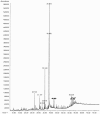Anticancer activity and phytochemical composition of wild Gundelia tournefortii
- PMID: 30655821
- PMCID: PMC6313074
- DOI: 10.3892/ol.2018.9602
Anticancer activity and phytochemical composition of wild Gundelia tournefortii
Abstract
Artichoke-like wild thistles are often used in Palestinian cuisine. One of the most commercially recognized species of these wild edible thistles is Gundelia tournefortii, a common plant in the Mediterranean region. G. tournefortii, or 'Akoob' in Arabic, remains uncultivated, harvested wild by local populations and considered highly valuable due to its reputed health benefits. The present study aimed to investigate the anticancer effects of G. tournefortii on the human colon carcinoma HCT-116 cell line. Methanol and hexane extracts were identified to exert considerable antitumor activity against the HCT-116 cancer cell line, while the aqueous extract was inactive. The phytochemical profiles of the methanol and hexane extracts were investigated using gas chromatography-mass spectrometry. A total of 6 of the 27 natural compounds identified, including sitosterol, stigmasterol, lupeol, gitoxigenin, α-amyrin and artemisinin, have been previously validated as being active against cancerous cells. Therefore, the presence of these phytochemicals in G. tournefortii is of importance in its role in preventing and treating cancer.
Keywords: Gundelia tournefortii; anticancer; gas chromatography-mass spectrometry; herbal medicine; phytochemicals; silylation.
Figures





References
-
- Ali-Shtayeh MS, Jamous RM, Al-Shafie JH, Elgharabah WA, Kherfan FA, Qarariah KH, Khdair IS, Soos IM, Musleh AA, Isa BA, et al. Traditional knowledge of wild edible plants used in Palestine (Northern West Bank): A comparative study. J Ethnobiol Ethnomed. 2008;4:13. doi: 10.1186/1746-4269-4-13. - DOI - PMC - PubMed
-
- Eddouks M, Maghrani M, Lemhadri A, Ouahidi ML, Jouad H. Ethnopharmacological survey of medicinal plants used for the treatment of diabetes mellitus, hypertension and cardiac diseases in the south-east region of Morocco (Tafilalet) J Ethnopharmacol. 2002;82:97–103. doi: 10.1016/S0378-8741(02)00164-2. - DOI - PubMed
LinkOut - more resources
Full Text Sources
